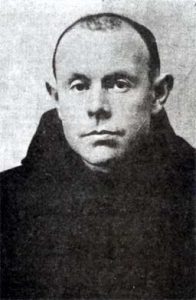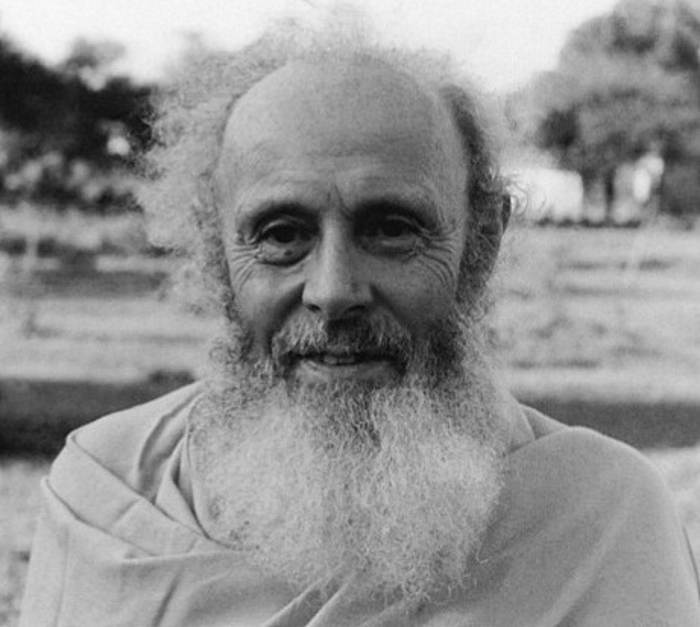 One of the best reasons for hope in the crisis through which at present the world is passing is certainly the growing interest shown by Western people in the East. Western man has in fact much to learn from the spiritual and cultural world of the East, which has evolved in ways very different from his own. Perhaps too it is only there that he will discover that inwardness which he so patently lacks and will recover that identity which seems to have escaped him – but this time an identity which will reveal to him the very depth of his own being. Abhishiktananada, Preface, Guru and Disciple.
One of the best reasons for hope in the crisis through which at present the world is passing is certainly the growing interest shown by Western people in the East. Western man has in fact much to learn from the spiritual and cultural world of the East, which has evolved in ways very different from his own. Perhaps too it is only there that he will discover that inwardness which he so patently lacks and will recover that identity which seems to have escaped him – but this time an identity which will reveal to him the very depth of his own being. Abhishiktananada, Preface, Guru and Disciple.
Swami Abhishiktananda
Dom Henri Le Saux, OSB, (Benedictine Monk)
Henri Le Saux, known as Abhishiktananda or Swami Abhishiktananda (lit. ‘the bliss of the anointed one of the Lord’), was a Frenchman, an old- fashioned priest of Breton seafaring stock, who had spent his early monkish days as a Benedictine monk in the monastery of Kergonan near Briac. His coming to India in 1948 was the fulfilment of a dream that had lingered round his consciousness since he was a novice – he wanted to bring Benedictine life to India. Abhishiktananda lived at Shantivanam, an ashram in Tamil Nadu he had founded with another French Catholic priest, Fr. Jules Monchanin
Henri Le Saux was born in France in 1910 and entered a Benedictine monastery in 1929. As early as 1934, he felt his monastic calling should be fulfilled in India, but many years passed before this was possible. Finally, he discovered another French Priest, Father Jules Monchanin, (already in India since 1939) who had a similar aspiration. In 1948, in a most unusual act by the Church, Fr Le Saux was granted an indult of exclaustration (allowing him to leave the enclosure and confines of monastic life) and permitted to join Fr. Monchanin. In 1950, they founded a small ashram named Shantivanam, in Trichinopoly, on the banks of the Cauvery River.
Sometime thereafter, Henri Le Saux was stunned by his experience meeting the great Indian sage Ramana Maharshi. Here was a devoted, loyal son of the Church, a Benedictine monk, given to years of Lectio Divina, and the Holy Eucharist in Latin, experiencing the totality of divinity in the presence of a silent Indian Saint. Shortly thereafter, Ramana Maharshi took samadhi (passed on) and the questions surrounding this experience of his were to ferment within the young Le Saux, and drive his enquiry for the remainder of his life.
“OM the mystery of the Spirit. But ultimately there is no name for the Father, for the Father can never be known in himself. He is known only through his self-manifestation in the Son and in the Holy Spirit. The Father is that last or fourth part of the OM, which is pure Silence.”
After Fr Monchanin died in 1957, Abhishiktananda was drawn toward North India and the Himalayas. In 1961-62 he build a small hermitage beside the holy river Ganges, in Uttarkashi, in the heart of the Himalayas. Until 1968, he alternated between there and Shantivanam and after that, made Uttarkashi his home until he died of a heart attack, at a hospital in Indore, during 1973.
Letting the Light In
Even when the westerner comes to sit at the feet of the East with every appearance of humility and sincerity, this is still too often done with a mistakenly passive attitude. This causes him to expect, if not demand, an immediate answer to his problems, and not only that, but an answer which must fit into the framework of his own categories.
It is indeed this quest, wrongly understood and wrongly undertaken, that in these days launches so many people, young and not so young, ‘on the road to Kathmandu’, in search of the sages and gurus of Rishikesh, Benares.and elsewhere. Alas, their quest seldom meets with success, and only too often ends in disappointment and frustration, with these unfortunate people then blaming India bitterly for not conforming with their preconceived ideas of it.
Most of the seekers, in fact, forget in the first place to empty the mind of all that is useless and irrelevant, and to open it up to its true depths – only there is it possible to hear the message of India. This message is diffused on every side in India, from its temples and holy places, and above all from truly spiritual people, of whom there is no lack, whatever people may say; but you have to know how to hear the message and how to recognise the true masters.
The truth is that there are right and wrong forms of passivity. One kind is entirely open and receptive, all set to hear, like a perfectly tuned radio, free from ‘interference’, which at once picks up the waves from the transmitter. But there is another kind of passivity which is unfortunately more common; this refuses to make any attempt at assimilation and is not in the least concerned to rid the mind of its prejudices and preoccupations – but, if you do not take the trouble at least to open the shutters, how can you expect even the midday sun to penetrate into your room?

Manas-tapas
But once again, as soon as India says this, the westerner at once begins to speculate what this Self is, about the meaning of the Void the nothingness, the fullness, to which the Scriptures constantly refer. But then the fullness which is conceived is no longer fullness; nor does nothingness or the void have anything to do with what abstract thought seeks to lay hold of.
Abhishiktananda – on the Guru
Beyond the experience of things and places, of watching or participating in worship, of reading or meditating on the Scriptures, of listening to lectures, there is the experience of meeting those in whose hearts the Invisible has been disclosed, and through whom the glory shines in all its brightness-which is the mystery of the guru.
The honourable title of ‘guru’ is unfortunately too often debased by being used inappropriately, if not sacrilegiously. No one should utter this word, let alone call someone his guru, if he himself does not yet have the heart and soul of a disciple.
It is in fact as unusual to meet a real disciple as it is to meet a real guru. Hindu tradition is right in saying that, when the disciple is ready, the guru automatically appears, and only those who are not yet worthy of it spend their time in running after gurus. Guru and disciple form a dyad, a pair, whose two components call for each other and belong together. No more than the two poles (of a magnet) can they exist without being related to each other. On the way towards unity they are a dyad. In the ultimate realisation they are a non-dual reciprocity.
The guru is certainly not any kind of teacher; not a professor, nor a preacher, nor an ordinary spiritual guide or director of souls, one who has learnt from books or perhaps from someone else that which he in turn passes on to others. The guru is one who in the first place has himself attained to the Real, and who knows by personal experience the path that leads there; one who is capable of giving the disciple the essential introduction to this path, and causing the immediate and ineffable experience, which he himself has, to spring up directly from and in the disciple’s heart-the lucid and transparent awareness that he is.
We may say that the mystery of the guru is actually the mystery of the spirit’s own depth. To come face to face with the guru is to come face to face with the ‘self’ at that level “of oneself that is at once real and most bidden.
The meeting with the guru is the essential meeting, the decisive turning point in a person’s life. But it is a meeting that can only happen when once you have passed beyond the spheres of sense and intellect. Its place lies Beyond, in the ‘fine point of the soul’, as the mystics say.
In human encounters duality is still left intact. At their best we may say that a fusion takes place and that the two become one in love and desire; but in the meeting of guru and disciple there is not even a fusion, for we are in the sphere of the original non-duality. Advaita remains for ever incomprehensible to anyone who has not first lived it existentially in his meeting with the guru.
That which the guru says springs up from the very heart of the disciple. It is not someone else who is speaking to him. He is not receiving in his mind thoughts which have come from elsewhere and have been transmitted by sensible means. When the vibrations of the master’s voice reach the disciple’s ear and the master’s eyes look deep into his own, then it is from within his own self, from the cave of his own heart, now at last discovered, that the thoughts proceed which reveal him to himself.
It therefore matters little what words the guru uses. Their whole power lies in the inward echoes which they cause. In seeing or hearing the guru, the disciple attains to the revelation of his own self, taking place at that deep level of himself for which everyone is essentially seeking, even if unconsciously.

Long ago the rishis of the Upanishads had celebrated the mystery of the guru:
But to hear it from just anyone is not enough,
even if he repeats it a hundred, a thousand times…
More subtle than the most subtle is that;
it cannot be obtained by any discussion…
Neither by reasoning, nor by ideas,
nor even by the simple recitation of the Vedas,
can it be known…
Wonderful is he who can utter it,
wonderful he who can hear it,
wonderful he who knows it, having been well taught…
(Katha Upanishad. 2)
The brahmin who has examined the secret of the worlds
that are reached by (performing) the Law and the Rites,
loses all desire…
Nothing transient can lead to the intransient…
Renouncing the world and full of faith,
he departs in search of the master
who will reveal to him the secret of Brahman.
With thoughts controlled and his heart at peace,
he receives from him the ultimate knowledge,
which reveals to him the True, the Imperishable,
the Man (purusha) within;
(Mundaka Upanishad. 1.2)
This page first appeared on Saieditor.com and is copyright C.Parnell
![]()

